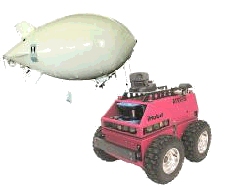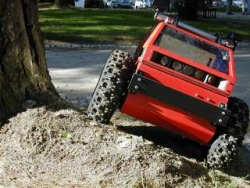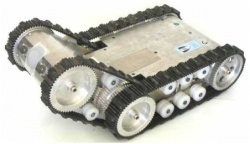Field Robotics: Difference between revisions
No edit summary |
|||
| Line 13: | Line 13: | ||
This project aimed at endowing a team of outdoors robots with cooperative navigation capabilities, so as to demonstrate the ability of the robots to act individually and cooperatively in search and rescue-like operation scenarios. Search and Rescue (SAR) operations are a challenging application for Robotics since, due to their nature, they naturally foster advances in Artificial Vision, Navigation in outdoors unstructured environments, Distributed Artificial Intelligence and Intelligent Control. | This project aimed at endowing a team of outdoors robots with cooperative navigation capabilities, so as to demonstrate the ability of the robots to act individually and cooperatively in search and rescue-like operation scenarios. Search and Rescue (SAR) operations are a challenging application for Robotics since, due to their nature, they naturally foster advances in Artificial Vision, Navigation in outdoors unstructured environments, Distributed Artificial Intelligence and Intelligent Control. | ||
The long-term objectives of the project consist of applications to SAR under large-scale catastrophe scenarios, namely after an earthquake. However, the | The long-term objectives of the project consist of applications to SAR under large-scale catastrophe scenarios, namely after an earthquake. However, the project was focused on the first steps towards the long-term goal and, as such, it referred to simpler scenarios and was based on some simplifying hypotheses, such as daylight operation and pre-planned robotic tasks. Also, the robotic team included only 2 robots, purposively made heterogeneous, both regarding the functional, hardware and software architectures: one wheeled and one aerial robot. Therefore, each type of robot could be assigned tasks with different requirements under SAR operations. | ||
The following is a list of problems that | The following is a list of problems that were, at least partially, addressed during the project: | ||
* Definition of | * Definition of functional and software architectures suitable for the integration of the subsystems composing the robotic team, oriented towards SAR applications. | ||
* Issues concerning topological, world-model-based and sensor-based navigation within unstructured environments, as well as their extension to cooperative navigation, where 2 robots communicate with each other to share information relevant for team navigation improvement. | * Issues concerning topological, world-model-based and sensor-based navigation within unstructured environments, as well as their extension to cooperative navigation, where 2 robots communicate with each other to share information relevant for team navigation improvement. | ||
* | * Aerial robot autonomous guidance. | ||
This project was funded by the ''Fundação para a Ciência e a Tecnologia'' (FCT) under the contract SRI/32546/99-00. | This project was funded by the ''Fundação para a Ciência e a Tecnologia'' (FCT) under the contract SRI/32546/99-00, and involved ISR/IST VisLab as well. | ||
'''Project link: http://rescue.isr.ist.utl.pt''' | '''Project link: http://rescue.isr.ist.utl.pt''' | ||
Revision as of 12:39, 3 January 2009
Introduction
ISLab has been developing, together with the Mobile Robotics Lab, and under the Theme B of ISR - Associate Lab, field robotics activities and applications, motivated by their novel scientific and technical challenges (such as the cooperation among land and aerial robots, and among robots and humans, in unstructured, frequently outdoors, scenarios), relevance for public policies, and potential for innovative results on unstructured environments blending sound theory and technological developments. The work has been driven so far by applications to search and rescue, as well as urban, scenarios.
Research activities
Initial work in field robotics comprised Search and Rescue (SAR) scenarios as a unifying testbed for diverse research approaches, ranging from the construction of new platforms, up to high-level coordination of mixed initiative human/robot teams. This sections enumerates these activities in a chronological sequence.

This project aimed at endowing a team of outdoors robots with cooperative navigation capabilities, so as to demonstrate the ability of the robots to act individually and cooperatively in search and rescue-like operation scenarios. Search and Rescue (SAR) operations are a challenging application for Robotics since, due to their nature, they naturally foster advances in Artificial Vision, Navigation in outdoors unstructured environments, Distributed Artificial Intelligence and Intelligent Control.
The long-term objectives of the project consist of applications to SAR under large-scale catastrophe scenarios, namely after an earthquake. However, the project was focused on the first steps towards the long-term goal and, as such, it referred to simpler scenarios and was based on some simplifying hypotheses, such as daylight operation and pre-planned robotic tasks. Also, the robotic team included only 2 robots, purposively made heterogeneous, both regarding the functional, hardware and software architectures: one wheeled and one aerial robot. Therefore, each type of robot could be assigned tasks with different requirements under SAR operations.
The following is a list of problems that were, at least partially, addressed during the project:
- Definition of functional and software architectures suitable for the integration of the subsystems composing the robotic team, oriented towards SAR applications.
- Issues concerning topological, world-model-based and sensor-based navigation within unstructured environments, as well as their extension to cooperative navigation, where 2 robots communicate with each other to share information relevant for team navigation improvement.
- Aerial robot autonomous guidance.
This project was funded by the Fundação para a Ciência e a Tecnologia (FCT) under the contract SRI/32546/99-00, and involved ISR/IST VisLab as well.
Project link: http://rescue.isr.ist.utl.pt
Localization and Map Building

In the context of the Rescue project previously referred, research on localization and map building using a land vehicle was carried out. In particular, SLAM techniques were used to build a topological map, as well as navigating along such a map. Topological maps differ from traditional metric maps in the fact that they represent topological relations among landmarks, rather than their exact coordinate position. Maps of urban subways are a classic example of such a map, as for traveling in a subway, the geographical relative positioning among stations is irrelevant. In the case of a SAR robot, cooperating with human teams, it is in general more efficient to communicate using landmark positions, instead of geographical coordinates.
Further details: http://lrm.isr.ist.utl.pt/rescue
RAPOSA robot

The RAPOSA robot is a tracked wheel robot build in cooperation with the Portuguese company IDMind, a ISR spinoff, together with the Lisbon firefighters corporation. This project comprised the design and construction of a tracked wheels robot, for the use in SAR operations. The input that the Lisbon firefighters provided was essential for the specification of the platform.
This project was funded by the Agência da Inovação (AdI).
Original project link: http://raposa.idmind.pt (hosted at IDMind since they were the consortium leaders)
Currently, active research is being carried out using this platform, namely in the following issues:
- autonomous docking to the cable (this robot is capable of attaching a cable providing power and a wireless link access point; is cable is also strong enough to lift the robot up)
- autonomous stair climbing as this robot was mechanically designed to be able to climb standard stairs; here a control algorithm is capable of driving the robot straight up along a staircase
- 3D remote operation using a Head Mounted Display (HMD) using the camera pairs to feed stereo video, and thus providing the operator with depth perception of the environment the robot is located in
Further details: RAPOSA robot
Blimp aerial robot
Aerial robots are capable of providing invaluable contribution for a cooperative team of robots, first because they can carry cameras and thus sending video stream captured from an altitude position, but also because they may be capable of mapping the terrain. These maps can then be used by land vehicles for navigation.
Research using a particular kind of aerial robot -- a blimp -- has being carried out at ISR, namely on these issues:
- providing the aerial 4m-long blimp robot with full indoors operation autonomy (from a technological standpoint), by endowing it with onboard computational power (based on a DSP), a video-camera, a video transmitter, NiCad batteries and a GPS device. All these but the GPS installation have been successfully accomplished so far. The DSP includes a video acquisition board and supports image processing plus guidance and control code. Connection to a GPS device is also possible, but not yet implemented. The onboard video transmitter is used to provide real-time image processing feedback (e.g., useful for debugging purposes) to the ground operator, who can also gain remote manual control of the robot whenever found appropriate;
- realistically simulating the aerial blimp and land ATRV-Jr robots, based on USARSim, such that developed code can be tested on the simulator and then switched to the actual blimp hardware without needing any extra modifications. Actually, control of the actual hardware and of the simulated blimp model can also be carried out simultaneously, if so desired;
- developing and testing vision-based algorithms for ground-lines following and object tracking (e.g., the ATRV-JR land robot) by the aerial blimp robot.
References
- Appearance based landmark selection and Reliability Evaluation for Topological Navigation, Lorenz Gertsmayr, Alexandre Bernardino, José Santos-Victor, Proc. IAV 2004 - 4th IFAC/EURON Symposium on Intelligent Autonomous Vehicles, Lisbon, Portugal, 2004
- Feature Extraction and Selection for Mobile Robot Navigation in Unstructured Environments, Alberto Vale, José Miguel Lucas, M. Isabel Ribeiro, Proc. IAV 2004 - 5th IFAC/Euron Symposium on Intelligent Autonomous Vehicles, Lisbon, Portugal, 2004
- Agent-Based Software Architecture for Multi-Robot Teams, João Frazão, Pedro Lima, Proc. IAV 2004 - 5th IFAC/EURON Symposium on Intelligent Autonomous Vehicles, Lisbon, Portugal, 2004
- Navigation Controllability of a Mobile Robot Population, Francisco Melo, M. Isabel Ribeiro, Pedro Lima, Proc. RoboCup 2004 Symposium, Lisbon, Portugal, 2004
- Bayesian Sensor Fusion for Cooperative Object Localization and World Modeling, Pedro Pinheiro, Pedro Lima, Proc. 8th Conference on Intelligent Autonomous Systems, IAS-8, Amsterdam, The Netherlands, 2004
- Logic Based Hybrid Decision System for a Multi-robot Team, Vasco Pires, Miguel Arroz, Luís Custódio, Proc. 8th Conference on Intelligent Autonomous Systems, Amsterdam, The Netherlands, 2004
- Event-driven Modelling and Control of a Mobile Robot Population, Francisco Melo, Pedro Lima, M. Isabel Ribeiro, Proc. IAS8 - 8th Conference on Intelligent Autonomous Systems, Amsterdam, The Netherlands. pp. 237-244, 2004
- Flugregler für ein autonomes Luftschiff (, Thomas Krause, Pedro Lima, Peter Protzel, Proc. German Conference on Autonomous Mobile Systems, Karlsruhe, Germany, 2003
- Environment Mapping as a Topological Representation, Alberto Vale, M. Isabel Ribeiro, Proc. of ICAR2003 - 11th International Conference on Advanced Robotics, Coimbra, Portugal, Vol. 1, pp.29-34, 2003
- The RESCUE Project: Cooperative Navigation for Rescue Robots, Pedro Lima, Luís Custódio, M. Isabel Ribeiro, José Santos-Victor, Proceedings do 1st International Workshop on Advances in Service Robotics, ASER’03, Bardolino, Itália, pp. 94-101, 2003 – PDF
- A Probabilistic Approach for the Localization of Mobile Robots in Topological Maps, Alberto Vale, M. Isabel Ribeiro, Proceedings da 10th IEEE Mediterranean Conference on Control and Automation, Lisbon, Portugal, 2002
- Hybrid abstractions: A search and rescue case study, P. Tabuada, G. J. Pappas, Pedro Lima, Proc. ECC2001 - European Control Conference, Porto, Portugal, 2001